From Roman baths to contemporary hot tubs, it’s all about therapy
by Sally Bouorm | August 1, 2011 11:56 am
By Vic Walker
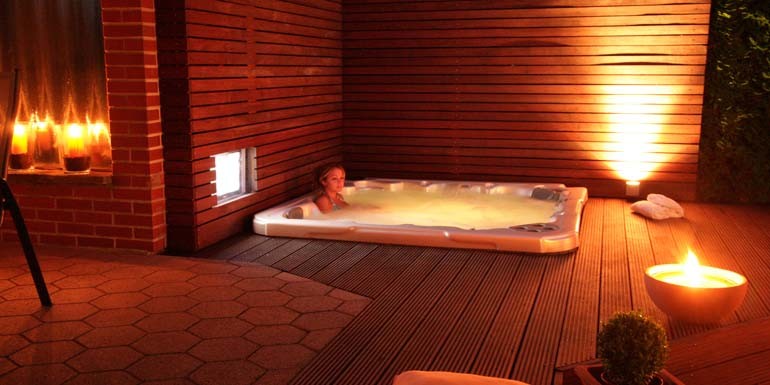 [1]
[1]Hot tubs and warm-water therapy have been around for centuries, and sometimes the rich, innovative, wellness-based history they have is overlooked. The practice of using hot or cold springs to cure ailments dates back to prehistoric times.
After a long tough day, hot tub owners look forward to a nice rejuvenating soak in warm water, as it helps to relieve stress and rejuvenate tired, weary bodies. However, when did soaking in hot water become a common practice for wellness? Where did it all start and why does it make people feel good? This article will review the history of salus per aquam—health through water.
Ancient bathing philosophy
The very first ‘hot tubs’ were created by Mother Nature, not by man. Archaeological investigations near hot springs in France and the Czech Republic have revealed Bronze Age weapons, while in Great Britain, ancient legends credited early Celtic kings with the discovery of the hot springs in Bath, England.
Many societies used the benefits of hot water therapy for hygiene and health purposes. For example, the Egyptians were thought to use baths for medicinal purposes as early as 2000 BC. Evidence also exists of spa construction in 600 BC from Phraortes, King of Media. The earliest forms of hot tubs were nothing more than large vessels in which very hot stones were placed to heat the water.
In Japan, the first ‘onsen’ (hot spring) opened[2] near Izumo around AD 737. This was followed by the development of indoor soaking tubs called ‘cypress ofuro,’ which were featured at ‘ryokan’ (inns) that resembled resort-like facilities, which focused on relaxation. It could be said that these establishments were the precursor to the modern spa retreat.
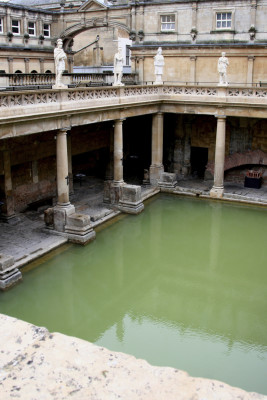 [3]
[3]The ancient Greeks and Romans also strongly believed in the therapeutic benefits of hot bath and mineral waters. Although the concept was largely reserved for the wealthy class, it was soon available to all in the form of public baths, which, at the time (460-370 BC), were considered healthy and beneficial for most diseases.
During this period, Hippocrates proposed a theory that all diseases are caused by an imbalance of bodily fluids. To regain balance, a change of habits and environment was advised, which included bathing, perspiration, walking and massages[4].
Following Greek methodology, Roman spas also had emphasis on medicinal purposes and were used largely as treatment centres for both wounded and healthy soldiers during periods of war. Spa treatments consisted of application of water to afflicted parts of the body and/or immersion of the whole body in the water[5]. Early on, these destination spas had little in common with the luxury-laden resorts of today.
The science of healing
Soaking in a hot tub is long known to make bathers feel better, but why? What is actually happening physically and psychologically? The answers to these questions differ depending on which of the concepts of therapeutic heated water immersion one is referring to.
Formally called hydropathy, hydrotherapy utilizes water for the relief of pain and the treatment of certain illnesses. It is the generic term for water therapies using jets, underwater massage and mineral baths. Synonymous with the term ‘water cure,’ which was used by practitioners in the 19th century, these treatments use physical water properties, such as temperature and pressure to stimulate blood circulation and treat the symptoms of certain diseases (e.g. rheumatoid arthritis and fibromyalgia).
Balneotherapy is derived from the Latin word balneum, meaning ‘bath.’ This term generally applies to any of the treatments performed at a spa facility. Balneotherapy refers to the medical use of the spas, as opposed to the recreational use. Treatments may involve using hot or cold water to create relaxation or stimulation by using moving water and massage.
| HOT SPRINGS: THE FIRST NATURAL HOT TUBS |
|---|
| While there are many geothermal springs in the U.K., some of the most famous can be found in the county of Bath in article text southwest England. Bath owes its name and its history to the hot mineral waters that rise at the King’s Spring and a few others nearby. These spas are the only true ‘hot’ springs that naturally occur in the U.K. (as defined by having temperatures higher than 37 C [98.6 F]). They include: ● Cross Bath 42.8 C (109 F); ● Stall Street Fountain 45.4 C (113.7 F); ● Hetling Spring 45.4 C (113.7 F); ● King’s Bath 45.6 C (114 F); and ● Hot Bath 47.2 C (117 F).Bath was not the only location with therapeutic hot springs; many other cultures around the world believed bathing in a particular spring, well or river resulted in physical and spiritual purification. Different forms of this practice have existed and are well documented among Native Americans, Persians, Babylonians, Egyptians, Greeks and Romans. There is substantial evidence suggesting and supporting the ancient belief in the healing and purifying properties of both hot and cold water. These naturally occurring springs that ‘healed with water’ contained many types of therapeutic mineral water. The dissolved substances in the water may include various salts and sulphur compounds. Mineral water can be sparkling (with effervescence) or still (without effervescence). While every spring is slightly different, most are rich in sodium (Na), sulphur (S), calcium (Ca), silica (SiO2), selenium (Se) and radium (Ra). Their benefits include muscle relaxation, skin exfoliation, toxin removal and increased blood circulation.There are two primary classifications of hot springs:Filtration hot springs These springs comprise geothermally heated mineral water that is initially fed by rainwater, which seeps into the Earth. As it travels, the water is subjected to increased energy through natural geothermal heat and is exposed to gases and often a wide variety of minerals from rock and mineral deposits. The water adsorbs the minerals via leaching, is heated by the geothermal source and then returns to the Earth’s surface.Primary hot springs These springs comprise geothermally heated mineral water where direct volcanic activity plays a far greater role in the spring formation process. One of the fundamental physical distinctions between a filtration and primary spring is the water’s mineral and gas content. Primary springs are often powered by magma chambers, which exist under the Earth’s surface, as well as in volcanically active regions. |
The strive for portability
Modern cement and plaster hot tubs are probably the most common image when the word comes to mind. These hot tubs are usually part of the overall pool design and have a bench-style seat with therapeutic jets mounted in the plaster. The water is typically heated with a natural gas heater and the jets use both water and air (from a blower) to provide hydrotherapy. However, it goes without saying, this hot tub style is not considered portable.
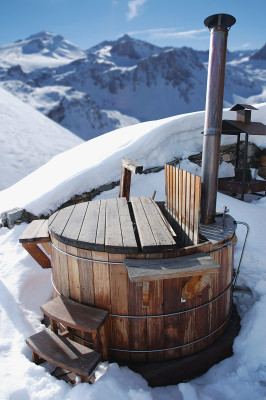 [6]
[6]While early pool builders were designing plaster hot tubs for customers, the first portable hot tubs were also being designed and modelled after wooden soaking tubs using old oak barrels, wine tanks and olive vats. These hot tubs started to appear in the ‘40s and were inspired by the previously mentioned Japanese ofuro.
Soon after this, wooden-staved soaking tubs came to market. They were built of redwood, cedar or teak and held together by steel bands. They ranged in depth—from 1 to 1.2 m (3 to 4 ft)—and usually included a wooden bench for seating along the hot tub’s inner circumference. Hot water soaking was the primary therapeutic purpose of these early designs.
While early wooden tubs lacked jets and bubbles, not to mention water management systems, their popularity increased with many users in the early ‘60s. Early designs, however, were prone to leak and keeping the water clean was a constant chore. Soon, however, a new element was introduced, which would change the face of hot tubs.
The bubble breakthrough
Most spa industry veterans know the Jacuzzi brothers’ story. While the name is synonymous with hot tubs, the company, comprising seven brothers who emigrated to the U.S. from Italy in the 1900s, was originally involved in the aviation industry before making a breakthrough in the hot tub sector.
In the mid-1920s, the family developed a deep-well pump, which revolutionized the agriculture industry. Thirty years later, a submersible aerating pump was invented and became the first portable hydrotherapy pump. This was the key component that would jumpstart the entire hot tub industry.
The pump’s swirling air-and-water mixture proved highly therapeutic and could turn virtually any vessel of water into a mini-spa. Sensing the consumer’s interest in health, fitness and leisure activities, in 1968 the company developed and marketed the first self-contained, fully integrated whirlpool bath[7].
With the new pump and jet combination, the jetted bath and hot tub were born and soon developed into the hot tub as it is known today. This new concept quickly gained acceptance from consumers and added momentum to this newly emerging product category.
The late 1960s also saw the emergence of some of the first viable fibreglass hot tub moulds, which used a gel-coat finish to make the surface less porous. Not only did these hot tubs cost less than their plaster counterparts, the fibreglass material allowed a more uniform production and they could be mass-produced in moulds.
Fibreglass hot tub designs also offered several advantages over units made of wood or plaster, such as increased seating comfort and greater consistency in the unit’s hydraulics. Even with these advantages, fibreglass hot tubs were still not the final solution to truly achieving a self-contained hot tub.
Advancing to acrylic
After the advent of fibreglass hot tubs, the next major innovation the hot tub industry would see came in the early ‘70s with vacuum-formed acrylic. This manufacturing process, which is still used today, uses cast or extruded acrylic sheet that is heated to a forming temperature and stretched onto (or into) a surface mould via vacuum pressure. After vacuum forming, the acrylic is reinforced using fibreglass or structural polyurethane to create a strong, watertight structural shell.
Vacuum-formed acrylic hot tubs included jets mounted into the structural walls that were powered by pumps and fed with both rigid and flexible tubing. Early designs were combined with a wooden cabinet (skirt), typically made of redwood, mahogany or cedar, and often reflected the old-style wooden barrel designs that inspired them. These new hot tubs were truly portable and could be moved to a new location if the owner decided to relocate or upgrade.
Additionally, these models had improved filtration systems to help keep the water clean, and heaters to maintain the water’s temperature. Early acrylic hot tub models utilized gas heating; however, they were replaced with high-efficient electric heaters, which soon became the industry standard.
One of the biggest advantages at the time was the hot tub water was constantly hot, which meant it could be used at anytime. The improved filter systems also made water maintenance easier and the water stayed cleaner longer. These advancements helped the product evolve and grow in popularity, as they became easier to maintain and own.
Also around this time, hot tub owners started using insulated covers made from expanded polystyrene (EPS) and marine-grade vinyl, which were designed to retain heat and provide safety.
Modern concepts, new designs
While wooden hot tubs and soakers still exist, modern hot tubs are available in several different forms, from plaster (inground models) to portable, self-contained units made of thermal plastic, fibreglass, vinyl and acrylic, the latter being the most popular. Continued improvements in materials and acrylic hot tub manufacturing allowed designers and engineers to create new and exciting shapes in a variety of sizes, along with more comfortable seating and targeted therapy designs.
Improved seating configurations
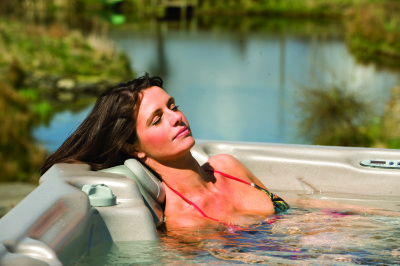 [8]
[8]Today’s hot tubs feature ergonomically driven specialized seating configurations (e.g. layback lounges, deep therapy, cool down, wrap around/pivot seats and built-in sun decks), which have allowed consumers to choose the design that best suits their needs.
Today’s comfortable hydrotherapy seats combine good body positioning with proper jet patterns and effective nozzle selection to provide a constant healing state for sore muscles and joints. With an understanding of buoyancy and proper ergonomic application, these seats provide ultimate comfort and high levels of hydrotherapy with minimal floating.
Another important element in seat design is the headrest. Combining hydromassage jets, an adjustable headrest and a soft pillow to cradle the head allows the jets to properly target the upper shoulder and trapezius muscles.
Improved therapeutic capabilities
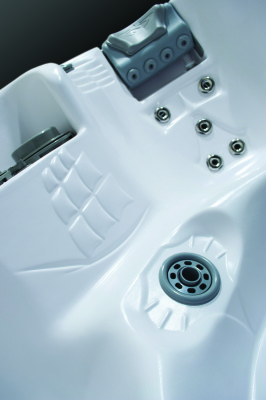 [9]
[9]Thanks to better plumbing efficiency and pump schematics, massage and therapeutic capabilities has been heightened in modern hot tub designs. For example, new specialized jet designs can target certain muscle conditions and provide a large variety of massage techniques, including deep tissue and acupressure.
A hot tub can have as many as three hydrotherapy pumps to facilitate targeted therapy designs. These special, high-volume pumps are designed to accommodate higher jet counts, while still maintaining high system pressures. These plumbing systems also feature spa-side diverter controls, which give the end user complete control over water flow, volume and direction.
Jet nozzles have also evolved in recent years to promote adjustability, while a large variety of speciality jets are also now available to further enhance hydrotherapy options. These include high-flow whirlpool, rotating, dual-rotating, directional, pulsating and rifling configurations, all of which allow designers and end users to customize hot tub seats to solve specific medical or massage needs.
Improved functionality
Improvements in controls and electronics have greatly impacted today’s hot tub designs, as well. In early hot tubs, air switches were used to turn pumps on/off and temperature controls were often hard to locate (e.g. behind a cabinet panel) and use. As solid-state electronics improved, an all-in-one component system, called the spa pack (circa 1977), united the pump, heater, control, blower and plumbing systems. This was the beginning of the never-ending march towards sophistication in the hot tub industry.
Today, these controllers feature colour screens with menus similar to what can be found on a cellphone. They allow consumers to easily set maintenance cycles and even save settings in a power outage. Most hot tubs can even be operated via remote control, which can operate the lights, pumps and even audio and video features. The trend is continuing to allow for integration into other modern electronics like smartphones.
Easier care and maintenance
As self-contained hot tubs became more sophisticated, water management systems also improved. In addition to the hot tub’s pump and filter, bromine, chlorine and/or heavy minerals (the same materials mariners used to keep water clean on long voyages) are used as the primary sanitizer. Often these are supplemented with an ozone generator, ultraviolet light (UV) sterilization and/or ionizers as a popular way to decrease the use of common hot tub chemicals.
New technologies have positively impacted the evolution of modern water management options, with ozone being the most common. These systems are not chemical-free, but are easier to maintain and use fewer chemicals.
Other sophisticated water management systems combine ozone with UV light to improve water quality and create a clean, healthy bathing environment without sacrificing efficiency. These dynamic systems use less power than a standard light bulb and result in average monthly heating costs ranging from $15 to $25.
Monthly ownership costs can be higher with hot tubs that are not equipped with circulation pumps, as the water management system is using less-efficient jet pumps to keep the water clean. Modern circulation pumps are magnetic-driven and the heat they generate is returned to the water to reduce the need for additional heating.
Conclusion
Water therapy has been utilized in several different forms throughout history. Ever since the early use of hot baths and mineral waters for healing purposes, people have been improving and advancing both the hot tub concept and the breakthrough technology behind them. As the industry continues to combine the knowledge of yesteryear with 21st century methodology[10], the future of the hot tub industry continues to look bright.
 Vic Walker is the product design manager at Dimension One Spas, a hot tub manufacturer in Vista, Calif. He has almost 20 years experience as an industrial designer and more than 12 years experience in the pool and hot tub industry where he has been awarded more than 15 patents for his contributions. He can be reached at vwalker@d1spas.com[11].
Vic Walker is the product design manager at Dimension One Spas, a hot tub manufacturer in Vista, Calif. He has almost 20 years experience as an industrial designer and more than 12 years experience in the pool and hot tub industry where he has been awarded more than 15 patents for his contributions. He can be reached at vwalker@d1spas.com[11].
- [Image]: http://www.poolspas.ca/wp-content/uploads/2015/06/wayfarer_night.jpg
- first ‘onsen’ (hot spring) opened: http://www.spafinder.com/spalifestyle/spa101/history.jsp
- [Image]: http://www.poolspas.ca/wp-content/uploads/2015/06/iStock_000006570377Large.jpg
- massages: http://www.greeka.com/eastern_aegean/ikaria/ikaria-excursions/ikaria-ancient-spa.htm
- body in the water: http://www.spasandstuff.com/anthology-of-the-hot-tub-a-brief-history-of-the-spa.
- [Image]: http://www.poolspas.ca/wp-content/uploads/2015/06/dreamstime_5849733.jpg
- whirlpool bath: http://www.jacuzzihottubs.com/about/timeline.html
- [Image]: http://www.poolspas.ca/wp-content/uploads/2015/06/DSC_0180.jpg
- [Image]: http://www.poolspas.ca/wp-content/uploads/2015/06/DSC_007611.jpg
- 21st century methodology: http://en.wikipedia.org/wiki/History_of_the_Hot_Tub
- vwalker@d1spas.com: mailto:vwalker@d1spas.com
Source URL: https://www.poolspamarketing.com/trade/from-roman-baths-to-contemporary-hot-tubs-its-all-about-therapy/